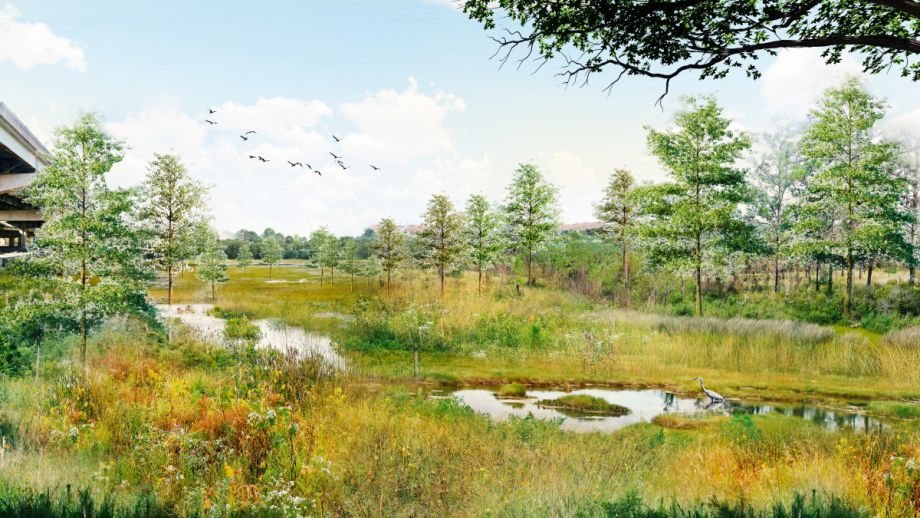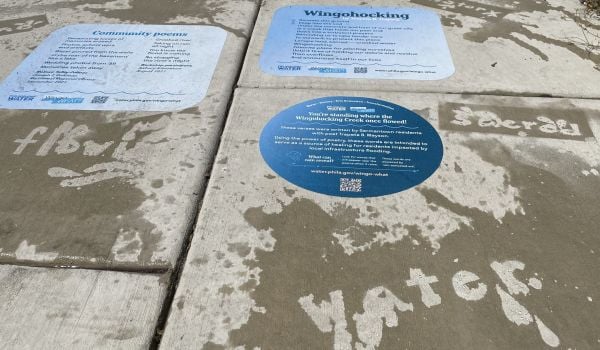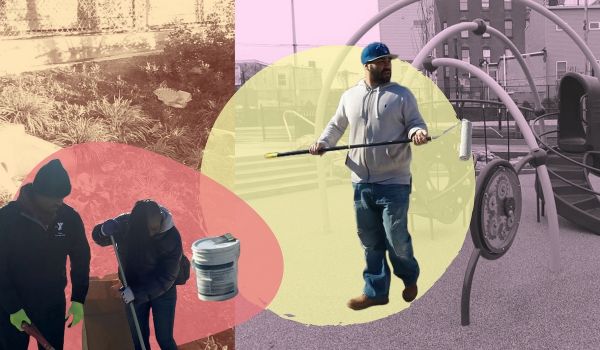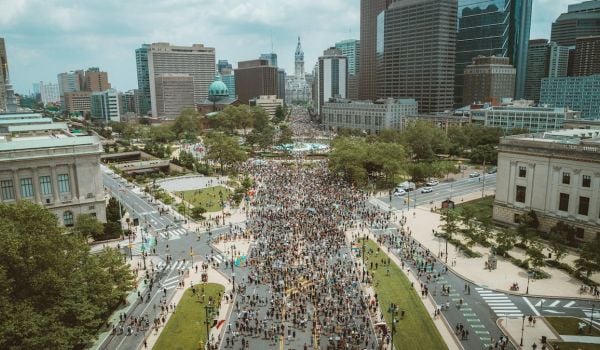After a decade of hydrology studies and planning, the Philadelphia International Airport is now breaking ground on a $30 million wetland mitigation effort in FDR Park, South Philadelphia’s largest park. Officials say the project includes a habitat restoration component but will also increase park accessibility, as frequent flooding has often left parts unusable.
“The golf course at FDR Park flooded severely, to the point that entire sections of the course were regularly underwater and unplayable,” recalls Kathryn Ott Lovell, Commissioner of Philadelphia Parks and Recreation. “The FDR Park Plan was developed to address this regular flooding, and rethink how the park’s 348 acres were being used to support both natural and recreational uses relevant to South Philadelphia families today.”
Long before the effects of climate change were even a concept considered in city planning, and before climate resiliency plans were a regular process for municipalities nationwide, most parks in Philadelphia prioritized recreation and protection of water sources.
FDR Park was no different. In 1914, famous park designer duo John Charles Olmsted and Frederick Law Olmsted Jr. — aka the Olmsted Brothers, the sons of New York City’s Central Park grounds architect Fredrick Law Olmsted Sr. — designed FDR Park’s curving walkways and meadows that hugged what was left of the park’s remaining historic creeks. (Today, those bodies of water are called the lakes.)
Over the years, FDR continued to be developed. In 1926, it was the site of Sesquicentennial and the Municipal Stadium Complex. Then in the 1960s, the South Philadelphia Sports Complex was erected. “The landscape of the park has always changed by the hands of people,” says Allison Schapker, chief project officer of nonprofit Fairmount Park Conservancy.
The park remains a favorite place for South Philadelphians to recreate. “The constituency in this area is very culturally and socioeconomically diverse,” says Fairmount Park Conservancy Spokesperson Cari Feiler Bender. It’s a favorite family picnic spot, a place to celebrate quinceñeras, a ground for all kinds of youth sports leagues, a venue for a South Asian market, and home to a small Swedish cultural museum.
Changes are also reflected in parts of the park no longer in use. The golf course within the park, lovingly called “the meadow” by some residents, is currently fallow. “It was literally and financially under water,” adds Bender, explaining that the vendor left the golf course around the beginning of the pandemic.
But while FDR park has long served residents well enough, officials say there was an opportunity to further serve residents’ needs and use the park as a key part of the city’s climate resilience. Since 2017, about a year into Lovell’s tenure as the city’s current Parks and Recreation commissioner, the city began to engage, and eventually formulate a plan to redefine the park.
This time it’s being revamped not just to accommodate more human activity, but to improve stormwater management. In 2019, the city announced the FDR Park Plan, a $250 million endeavor, after three years of planning. Major collaborators include the city’s Parks and Recreation Department, Philadelphia International Airport and nonprofits Fairmount Park Conservancy and Friends of FDR.
While 148-acres will be part of developing for human-centered programming — such new picnic areas, dedicated sports fields and other recreating areas around the edges of the park (what planners call the “urban edge”) — the other 200 acres will be dedicated ecological core, a key part of encouraging native wildlife habitats and improving stormwater management.
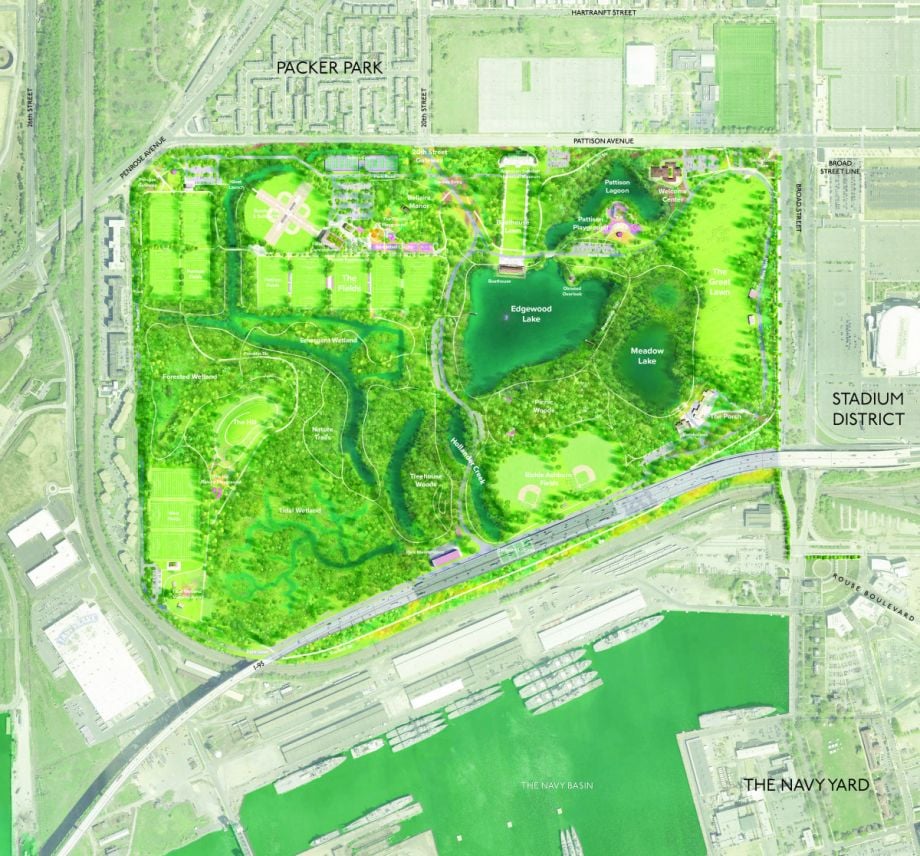
(Graphic courtesy of Philadelphia Parks and Recreation)
“FDR Park is a home to so many rich Philadelphia communities, from birders and hikers, to youth athletes, cultural institutions, and naturalists,” says Lovell. “The wetland project and Nature Phase of the Park Plan will deliver for those who love FDR Park today, while building a sustainable, resilient foundation that will allow future generations of South Philadelphia families to enjoy FDR Park for years to come.
As of now, large swaths of the park regularly flood. Even in times of drought, trees located in the now-defunct golf course pool at the roots with water, as there is currently not a sufficient way to store storm water.
While the park was designed with a tide gate that would drain into the Delaware River, a 40-foot hill of infill (cleaned soil from various construction projects over the decades) and other obstacles has essentially hindered the flow of water in an efficient way out of what was historically a marshland.
With no way out, the water goes up, and the tide gate doesn’t function properly. In the worst-case scenarios, such as heavy rains brought on by extreme flooding events, storm water from major roads like Broad Street and Interstate 95 all drain into the Park.
“Think of [FDR] like a bathtub,” says Schapker. “If your drain doesn’t work, your tide gate doesn’t work. Then you have a clogged bathtub.”
The plan began with 18 months of community engagement. Surveys and workshops were conducted in seven languages, with the city implementing “workshops-in-a-box” to encourage stakeholders unfamiliar with city planning vernacular to eliminate cultural barriers and participate fully in their feedback.
While Bender notes some resistance by a few residents who don’t want the old golf course to be redeveloped — especially as trees will have to be removed — she believes there can be compromises. “It’s over 348 acres. There is room for everyone.”
The project finally broke ground with a 18,000-square-foot welcome center in May. The welcome center will adapt a historic horse stable into a 4,000-square-foot cafe, and build out a 6,700-square-foot multipurpose room.
Then on Aug. 18, the Philadelphia International Airport, which shares a watershed with parts of the park and helped fund a hydrology study, announced that they’re breaking ground on their piece of the plan: the $30 Wetland Mitigation Development Project.
The airport will take the lead on habitat restoration on the historic marshland — by planting native species and uprooting invasive ones, it will also use the 40-foot hill of construction infill to raise parts of the park in order to build in more water storage. Additionally, the project will remove existing debris within corresponding waterways and build two new tide gates, improving the overall efficiency of drainage.
Schapker, Lovell and Bender don’t have to wait for the next major flood to know that the park, as is, cannot handle the impact of more frequent and possibly worse, flooding events. Hurricane Sandy happened 10 years ago and Hurricane Ida just a year ago.
“Our parks were first built to protect our water,” says Schapker. “This plan considers the reality on the ground at present and future predictions.”
There are no estimates yet on how much the city will spend annually to operate the park. “It’s too far in the future to know for sure,” says Bender.
The team credits the excitement and overwhelmingly positive reception of the park to homegrown expertise, like urban designers and architects WRT Design, South Philadelphia residents and the Water Department. With all elements of science and culture combined, Schapker says the plan will ultimately strike a balance and fill a need for green space in a heavily urbanized South Philadelphia.
“The urban edge, the ecological core — both of these work together to make sure they’re compatible with human activity and that we’re meeting on the ground conditions.”

Marielle Argueza is Next City’s Equitable Cities Reporting Fellow for Racial Justice Narratives in partnership with Triad City Beat in Greensboro, North Carolina. Formerly Next City's INN/Columbia Journalism School intern for Summer-Fall 2022, she’s a journalist with more than a decade of experience reporting on education, immigration, labor, criminal justice, climate and more. Her work in K-12 education is award-winning and she was recognized multiple times by the California News Publishers Association. She is a recent graduate of Columbia Journalism School, where she was Toni Stabile Investigative Fellow. Her work includes a story on Harlem’s last assisted-living facility for people living with HIV/AIDS; a profile on New York State’s first Farmers Union; and a database of deaths within the Milwaukee County Jail. She is also a recipient of other fellowships and scholarships from several notable organizations within the news industry including the Asian American Journalists Association, Association of Alternative Newsmedia, ProPublica, and the Journalism and Women Symposium.

